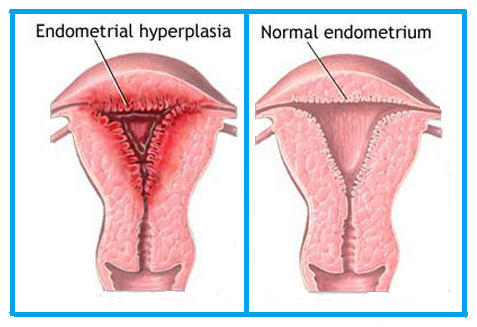- AyurVAID Pharmacy

Endometrial hyperplasia is the abnormal thickening of the lining of the uterus due to an increase in the number of endometrial glands. This disorder most often affects young women who are just beginning to menstruate and older women
approaching menopause. In some women, microscopic examination of endometrial tissue may reveal abnormalities in cellular nuclei, a precancerous disorder sometimes referred to as atypical adenomatous hyperplasia, which may lead to endometrial (uterine) cancer. Fortunately, there are effective endometrial hyperplasia treatment options available, ranging from hormonal therapies to surgical interventions, which can help manage and address this condition and its associated risks, including the potential progression to uterine cancer.
Endometrial malignancy
Endometrial hyperplasia most often is caused by excess estrogen without progesterone. If ovulation does not occur, progesterone is not made, and the lining is not shed. The endometrium may continue to grow in response to estrogen. The cells that make up the lining may crowd together and may become abnormal.
Endometrial Hyperplasia symptoms may include:
1. Vaginal bleeding between menstrual periods or after menopause.
2. Heavy menstrual bleeding.
3. Periods that last longer than usual.
4. Pain during sexual intercourse.
5. Amenorrhea (absence of menstrual periods)
6. Anovulatory periods (menstrual cycles without ovulation)
During a bimanual examination of the pelvis, hyperplasia of uterus may be noticed. Endometrial hyperplasia of uterus is diagnosed by ultrasound (TVS), endometrial biopsy, dilatation & curettage & Hysteroscopy. The treatment of endometrial hyperplasia of uterus is mainly done by hormonal treatment (especially by progesterone) and by surgical treatment such as hysterectomy, which are having their side effects
Sthambhana (hemostyptic), Shodhadhara (anti-inflammatory), Tridoshahar, Apana Vayu dushti correction
Apollo AyurVAID’s rigorous process driven protocols will help you in an evidence based diagnosis of Endometrial Hyperplasia. Knowing well that it is the confirmed diagnosis, Vaid: at Apollo AyurVAID will take down the contributory factors to your disease, the current complaints will be noted.
Based upon classical shastra parikshas,Vaid: will establish a disease-cause-disease pathway and plan a reversal strategy based upon that. At Apollo AyurVAID one expect depending upon the cause of endometrial hyperplasia, a complete alleviation of symptoms, significant reduction of endometrial thickness to extent reversing it to normal range, with a root cause address to prevent the relapse.
In Ayurveda endometrial hyperplasia of uterus can be correlated with Yonivyapada. The Lakshanas shara Yonivyapada is Artava Atipravrutti (excessive bleeding), Akala Artava Dashana (irregular menstruation),Chosha evum Daha.
*Outcome may vary from patient to patient
Popular Searches: DiseasesTreatmentsDoctorsHospitalsWhole person careRefer a patientInsurance